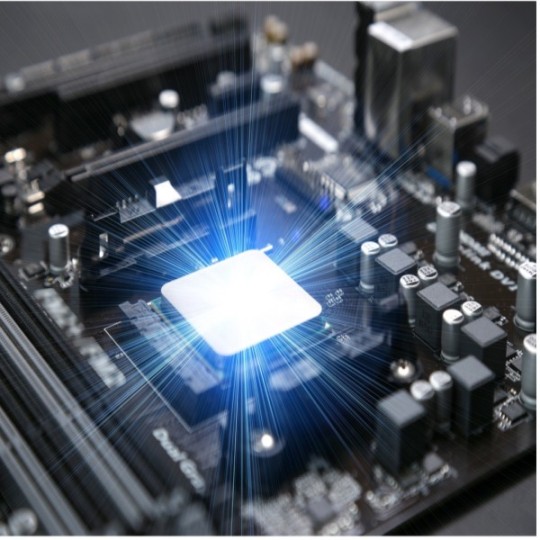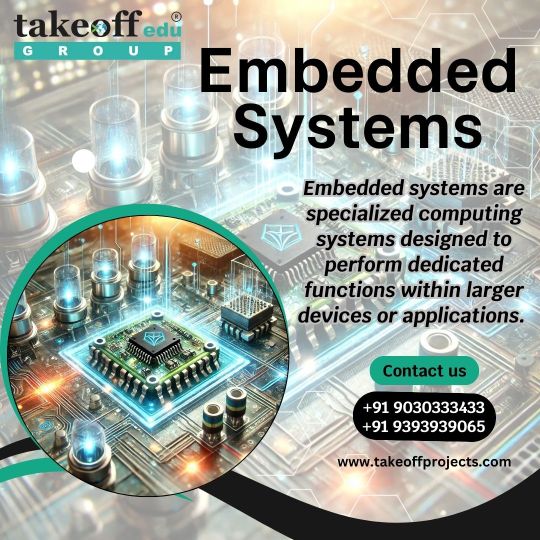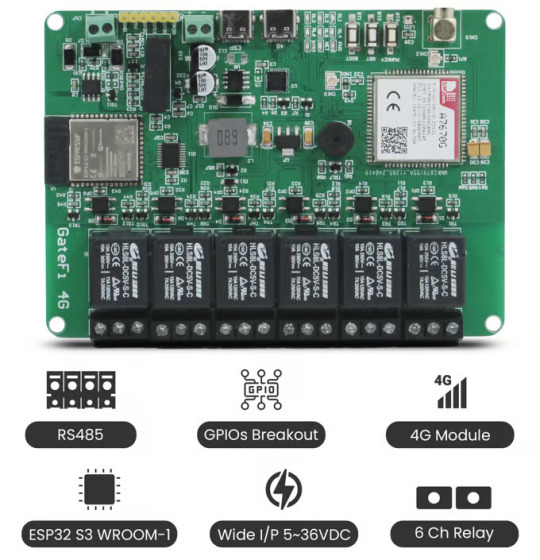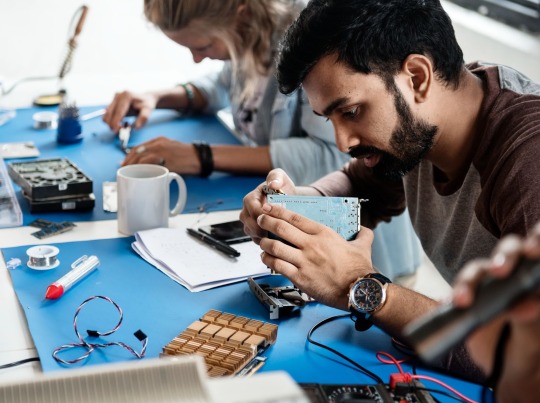#embedded applications
Explore tagged Tumblr posts
Text
Understanding Embedded Computing Systems and their Role in the Modern World
Embedded systems are specialized computer systems designed to perform dedicated functions within larger mechanical or electrical systems. Unlike general-purpose computers like laptops and desktop PCs, embedded systems are designed to operate on specific tasks and are not easily reprogrammable for other uses. Embedded System Hardware At the core of any embedded system is a microcontroller or microprocessor chip that acts as the processing brain. This chip contains the CPU along with RAM, ROM, I/O ports and other components integrated onto a single chip. Peripherals like sensors, displays, network ports etc. are connected to the microcontroller through its input/output ports. Embedded systems also contain supporting hardware like power supply circuits, timing crystal oscillators etc. Operating Systems for Embedded Devices While general purpose computers run full featured operating systems like Windows, Linux or MacOS, embedded systems commonly use specialized Real Time Operating Systems (RTOS). RTOS are lean and efficient kernels optimized for real-time processing with minimal overhead. Popular RTOS include FreeRTOS, QNX, VxWorks etc. Some simple devices run without an OS, accessing hardware directly via initialization code. Programming Embedded Systems Embedded Computing System are programmed using low level languages like C and C++ for maximum efficiency and control over hardware. Assembler language is also used in some applications. Programmers need expertise in Microcontroller architecture, peripherals, memory management etc. Tools include compilers, linkers, simulators and debuggers tailored for embedded development. Applications of Embedded Computing Embedded systems have revolutionized various industries by bringing intelligence and connectivity to everyday devices. Some key application areas include: Get more insights on Embedded Computing
Unlock More Insights—Explore the Report in the Language You Prefer
French
German
Italian
Russian
Japanese
Chinese
Korean
Portuguese
Alice Mutum is a seasoned senior content editor at Coherent Market Insights, leveraging extensive expertise gained from her previous role as a content writer. With seven years in content development, Alice masterfully employs SEO best practices and cutting-edge digital marketing strategies to craft high-ranking, impactful content. As an editor, she meticulously ensures flawless grammar and punctuation, precise data accuracy, and perfect alignment with audience needs in every research report. Alice's dedication to excellence and her strategic approach to content make her an invaluable asset in the world of market insights.
(LinkedIn: www.linkedin.com/in/alice-mutum-3b247b137 )

#Embedded Computing#Embedded Systems#Microcontrollers#Embedded Software#Iot#Embedded Hardware#Embedded Programming#Edge Computing#Embedded Applications#Industrial Automation
0 notes
Text
youtube
NXP: MCX A Series Launch Video
https://www.futureelectronics.com/resources/featured-products/nxp-mcx-n-mcx-a-microcontrollers . MCX A Series all-purpose microcontrollers (MCUs) address a wide range of applications with scalable device options, low power and intelligent peripherals. Designed to allow engineers to do more, the new MCX A series is optimized with the essential features, innovative power architecture and software compatibility required by many embedded applications. https://youtu.be/fjNG2t4TBXQ
#nxp#MCX#MCX A#all-purpose microcontrollers#MCU#MCX A series#microchip#small-footprint MCU#software compatibility#embedded applications#industrial sensors#motor control#power system#controllers#IoT devices#Youtube
0 notes
Text
I think the biggest thing about Sunless Skies that gives it a different feel than Fallen London (other than the obvious gameplay differences) is the position of your player in the universe. In Flondon, your character is important and singular. The storyline is oriented around mastery and influence: starting from the bottom and climbing to the top, gaining recognition and reach as you unravel the world's secrets. While social play is encouraged, there are few in-game characters comparable to the PC, and in many plotlines the idea of being the only or the first one to accomplish a certain thing is specifically emphasized. The story is about what path you take to Make Your Name.
In Sskies, that goal is not absent, but there's a sense of...fleetingness, that never quite leaves you. There are many others like you. You see their entries in the cache logs, they are mentioned in the ports and pubs, you find their frozen bodies littering the open void like stones. It is the very first thing you know when you start: you are a Captain filling the shoes of a predecessor, and in all likelihood simply keeping them warm for the next to come after you, and the next. Your time is limited. Your significance to the wild, vast, ancient skies is negligible. The drive in the story comes from this: Your space in this universe is small and hard fought. Make it count.
#fallen london#sunless skies#i would say I like the sskies version better but honestly I think they both work great for their own applications#both in setting and for the way the games are played#I've seen the flondon fame gathering thing criticized occasionally but honestly I've always read it as like#a tongue in cheek parody on rich Victorian ego#as well as being inherently flexible,because of how players tend to treat the stories#for some it will be about doing Everything,but for most it's about getting a wide choice of what to focus on and how to specialize#in a character development sense#and also the story really is about How you get there and who you are while doing so#what with the quirks and everything#that's a mechanic that's notably absent from sskies#probably because your character is meant to be less permanent and less noticeable as an individual#most of the in-game character defining you do relates to building out their past with facets#because their present and future are so tentative and so embedded in the bigger picture#I really really like it. it's almost like the world is more the character#but ALSO the feel of like. the game does not treat loss lightly. there are Implications and narrative even for the loss of unnamed crew#it all also plays in so so nicely to the switch from flondon's tightly controlled sheltered chaos#(enclosed in a cave,tightly governed by the Bazaar,the sense of a new world building itself on top of older ones)#vs the Reach being so open and fraught and wild and legitimately teetering on the brink in every way#the way the characters are treated fits so so well into the political landscapes too#like. sskies is wartime.#the messaging that you the individual is fleeting and disposable and that it's what you donate your effort to that matters is Constant#so it works really really well there#oh now I want to go on again about how well the flondon way works in a meta sense for gameplay and community building#because it's emphasizing individuality while also paired so heavily with social actions and -#ouuuuuuuuuuuuuuuuuuu#hey gang have i mentioned. I like fallen london a lot. hey have i mentioned yet that I like flondon A Lot#voidrambles#<- It Sure Does
86 notes
·
View notes
Text
Hash Tables in Programming: The Ubiquitous Utility for Efficient Data Lookup
Hash tables are fundamental to modern software development, powering everything from database indexing to web caches and compiler implementations. Despite their simplicity, they solve surprisingly complex problems across different fields of computer science.
Introduction: Hash Tables – The Unsung Heroes of Programming When you open a well-organized filing cabinet, you can quickly find what you’re looking for without flipping through every folder. In programming, hash tables serve a similar purpose: they allow us to store and retrieve data with incredible speed and efficiency. Hash tables are fundamental to modern software development, powering…
#application-developement#c-sharp#embedded-development#hash-tables#java#javascript#learn-application-development#micropython#mobile-development#programming#programming-logic#programming-tables#python#software-developement#software-development#web-development
0 notes
Text
Prompt engineering: How to talk to AIs like ChatGPT?
New Post has been published on https://thedigitalinsider.com/prompt-engineering-how-to-talk-to-ais-like-chatgpt/
Prompt engineering: How to talk to AIs like ChatGPT?
Large Language Models (LLMs) like ChatGPT have become a staple in machine learning and artificial intelligence discussions, marking a profound shift in these fields. Long overshadowed by more mainstream technologies, LLMs have emerged as pivotal elements in everyday digital interactions for millions worldwide.
As a researcher with over four years of experience in this domain, I have engaged deeply with these tools, gaining valuable insights, especially recently. Exploring the nuances of LLMs has significantly enhanced my grasp of prompt engineering. This article introduces the concept of prompt engineering, exploring the various strategies employed to guide LLMs effectively.
What are prompts and prompt engineering?
Prompt engineering is the strategic creation prompts for pre-trained models like GPT, BERT, and others; prompts describe what we request the model to do. This process aims to steer these models towards generating a specific behavior that we seek.
Successful prompt engineering hinges on meticulously defining the prompt with appropriate examples, relevant context, and clear directives. It demands a profound understanding of the model’s underlying mechanisms and the nature of the problem at hand.
This knowledge is crucial to ensure that the examples incorporated in the prompt are as representative and varied as possible, closely mirroring the real-world distribution of input-output pairs that characterize the problem.
Consider the simple task of translating text from English to French. Achieving this through prompt engineering is remarkably straightforward. One needs a pre-trained model, such as GPT-4, and a well-crafted prompt.
This prompt should 1) outline the task 2) provide a few example sentences with their translations 3) include the specific sentence requiring translation, as demonstrated in the figure below. That’s it! GPT-4, already trained on an enormous corpus, inherently grasps the concept of translation. It merely requires the correct prompt to apply its learned skills.
Example of a prompt
Zero, one, and few-shot prompts
Prompts can be classified in various ways. Take, for instance, zero-shot, one-shot, and few-shot prompts, which correspond to the number of examples provided to the model for task execution.
In zero-shot settings, the Large Language Model (LLM) receives only the task description and input. For example, in the figure, we ask it to translate ‘cheese’. These zero-shot prompts already demonstrate impressive performance, as evidenced by this particular paper.
Despite their efficacy, I generally avoid zero-shot prompts for a couple of reasons. Firstly, adding just a few examples can significantly enhance performance, and you don’t need many, as highlighted in another paper.
More crucially, by incorporating a few examples, you not only clarify the task for the model but also illustrate the desired response format. In zero-shot translation, the model might respond with, “Sure, here is the translation of your text…”.
However, with a few-shot approach, it learns more effectively that a text followed by “=>” indicates that the subsequent content should directly be the translation. This nuance is useful, especially when seeking to precisely control the model’s output for commercial applications.
Dynamic prompts
Utilizing tools like langchain, we can also create dynamic prompts. In the example mentioned earlier, this means that ‘cheese’ becomes a variable, alterable to any word we wish to translate. This seemingly straightforward concept paves the way for complex systems, where parts of the prompt are either removed or added in response to user interaction.
For instance, a dynamic prompt for a chatbot might incorporate elements from the ongoing conversation with a user. This approach enhances the bot’s ability to understand and react more appropriately to the context of the discussion.
Similarly, a prompt initially designed for text generation can be dynamically adapted to revise a given text, ensuring it aligns with previously generated content. This flexibility allows for more nuanced and context-aware interactions, significantly enriching the user experience and simplifying developments.
Prompt chaining
Prompts can be employed sequentially, a technique known as prompt chaining. In this method, a prompt used to respond to a user query might incorporate the summary of a previous query as a variable. This summary itself could be the output of a separate prompt. This layered approach allows for more complex and context-aware responses, as each prompt builds upon the output of the previous one.
Continuous prompt
This is a more sophisticated approach that uses the fundamentals of LLMs. Prompts consist of words, and these words are processed by Large Language Models (LLMs) through word embeddings, which are essentially numerical representations of words. Consequently, rather than solely relying on textual prompts, we can employ an optimization algorithm like Stochastic Gradient Descent directly on the prompt embedding representation. This method essentially refines the input, as opposed to fine-tuning the model itself. For example, in this article, they enhance the model’s performance by concatenating a fine-tuned prompt with a standard prompt.
Only-shot prompt?
This method, while not officially named, stems from insights in a research paper that posits that task descriptions and directives in prompts are largely useless.
The paper illustrates that prompts can contain important, irrelevant, or even contradictory information without significantly impacting the outcome, provided there are sufficient high-quality examples. This was a lesson I learned through experience prior to discovering the paper.
I used to craft complex prompts laden more with directives and task descriptions than examples. However, at some point, I experimented with using only examples, omitting directives and task descriptions entirely, and observed no notable difference.
Essentially, my detailed instructions were superfluous; the model prioritized the examples. This can be explained because the exemples are more isomorphic to the final output to generate. The model’s attention mechanism, thus, focuses more on examples than on any other aspect of the prompt.
Chain of thought prompts
Chain of Thought (CoT) prompts involve structuring examples not as simple “X -> Y” transformations but as “X -> Deliberating on X -> Y”. This format guides the model to engage in a thought process about X before arriving at the final answer Y. If you’re curious about the nuances of this approach, there’s a detailed paper on the subject.
However, it’s crucial to remember that most Modern Large Language Models (LLMs) are autoregressive. This means that while the “X -> Deliberating on X -> Y” structure is effective, a format like “X -> Y -> Explain why Y is the answer” is less so.
In the latter case, the model has already determined Y and will then concoct a rationale for its choice, which can lead to flawed or even comical reasoning. Recognizing the autoregressive nature of LLMs is essential for efficient prompt engineering.
Further research has expanded on the CoT concept. More sophisticated strategies include self-consistency, which generates multiple CoT responses and selects the best one (paper here), and the Tree of Thoughts approach, which accommodates non-linear thinking, as explored in several papers (see 1 & 2). These advancements underscore the evolving complexity and great potential of prompt engineering.
More & more
The world of prompting techniques is rapidly evolving, making it a challenge to stay current. While it’s impossible to cover every new development in this article, here’s a quick overview of other notable techniques:
Self-ask: This method trains the model to ask itself follow-up questions about specific details of a problem, enhancing its ability to answer the original question more precisely.
Meta-Prompting: Here, the model engages in a dialogue with itself, critiquing its own thought process, aiming to produce a more coherent outcome.
Least to Most: This approach teaches the model to deconstruct a complex problem into smaller sub-problems, facilitating a more effective solution-finding process.
Persona/Role Prompting: In this technique, the model is instructed to assume a specific role or personality, altering its responses accordingly.
Through this article, I hope to have introduced you to some of the more innovative and lesser-known prompt engineering techniques. The creativity and ingenuity in current research indicate that we are just beginning to uncover the full potential of these models and the prompts we use to control them.
#algorithm#amp#applications#approach#Article#artificial#Artificial Intelligence#attention#attention mechanism#AutoRegressive#Behavior#BERT#bot#challenge#chatbot#chatGPT#complexity#content#continuous#craft#creativity#details#development#Developments#Dialogue#embeddings#employed#engineering#English#Explained
0 notes
Text
#GPS L2 ceramic patch antenna#L2 band GPS antenna#GNSS ceramic patch antenna#Ceramic patch antenna for GPS#Automotive GPS L2 antenna#GPS Antenna#GNSS antenna#Embedded Antenna#1227.6MHz GPS L2 Ceramic Patch Antenna#High-precision 1227.6MHz GPS L2 ceramic patch antenna#High-gain GPS L2 band antenna for UAV and drones#GPS antenna australia#gnss antenna russia#gps ceramic antenna USA#gps patch antenna hungary#active gnss antenna india#Compact ceramic patch antenna for GPS L2 applications#Industrial-grade GPS L2 band antenna for IoT devices#gps l2 ceramic patch antenna in india
0 notes
Text
Embedded Systems: Driving Innovation in Technology
Embedded systems are specialized computing systems designed to perform dedicated functions within larger devices or applications. These systems integrate hardware and software components to execute tasks with precision, reliability, and efficiency. They are embedded in devices ranging from household appliances like washing machines and microwaves to complex industrial machines, medical equipment, and automotive systems.

An embedded system's core lies a microcontroller or microprocessor, which controls and processes data. Sensors, actuators, and communication interfaces are often part of the system, enabling it to interact with the physical environment. For instance, in a smart thermostat, an embedded system monitors temperature, processes user inputs, and adjusts heating or cooling accordingly.
Embedded systems are valued for their compact size, low power consumption, and cost-effectiveness. They are tailored for real-time operations, ensuring quick and accurate responses to specific tasks. Industries such as automotive, healthcare, telecommunications, and consumer electronics heavily rely on these systems to innovate and improve product functionality.
As technology advances, embedded systems are becoming more sophisticated, incorporating artificial intelligence (AI), Internet of Things (IoT) connectivity, and advanced sensors. These developments are paving the way for smarter devices and systems, transforming how we live and work.
In a world increasingly driven by automation and smart technology, embedded systems play a crucial role in shaping the future of innovation.
#Embedded Systems#Microcontroller Technology#Real-Time Systems#IoT and Embedded Systems#Embedded Software Development#Embedded Hardware Design#Embedded System Applications
0 notes
Text
GateFi 6 Channel Powered by ESP32: The Future of IoT Connectivity with 4G

The rapidly advancing world of IoT (Internet of Things) and automation calls for devices that offer robust, flexible, and high-performance capabilities. The GateFi 6 Channel Powered by ESP32 with 4G Connectivity Microcontroller stands as a powerful solution for these needs, designed for industrial and commercial applications that demand reliable control, remote access, and seamless communication.
In this post, we will delve into the key features and capabilities that make the GateFi 6 Channel ESP32 S3 WROOM-1 an ideal choice for building smart systems with efficient relay control, fast connectivity, and advanced communication options.
What is GateFi 6 Channel Powered by ESP32 with 4G Connectivity?
The GateFi 6 Channel is a microcontroller designed to offer versatile and high-performance solutions for a wide range of IoT applications. Powered by the robust ESP32, a popular microcontroller that integrates Wi-Fi and Bluetooth capabilities, the GateFi 6 Channel is further enhanced with 4G connectivity. This combination ensures that your devices have seamless communication over the internet, even in areas where traditional Wi-Fi infrastructure might not be available or reliable.
This device can handle six independent channels simultaneously, making it ideal for tasks that require multiple communication points or data collection from various sensors, devices, or systems. The ESP32 ensures efficient processing and connectivity, while the 4G module guarantees that data can be transferred quickly and reliably over mobile networks.
Key Features
ESP32 S3 WROOM-1 Microcontroller: The ESP32 microcontroller is the heart of the GateFi 6 Channel. It provides a high processing power with dual-core capabilities, enabling fast data processing and communication. Additionally, the ESP32's Wi-Fi and Bluetooth support offer plenty of flexibility in local wireless communication.
6-Channel Relays with Optically Isolated Circuits: Comes equipped with 6 relay channels, which provide the ability to control a wide range of devices such as motors, alarms, or industrial machinery. These relays are optically isolated, offering protection against electrical surges and ensuring that high-voltage circuits are safely separated from the sensitive low-voltage control system. This isolation increases the reliability and longevity of your equipment, particularly in industrial applications where power spikes are common.
4G Connectivity with A7670G Module: The A7670G module provides 4G LTE connectivity, ensuring fast data transmission speeds even in remote areas with poor Wi-Fi coverage. This feature is perfect for applications like remote monitoring, data collection, and control over large distances. With the A7670G module, you can be confident in maintaining stable and fast communication, even in environments where traditional internet infrastructure might be lacking.
Visual and Audio Alerts: RGB WS2812 LED & Buzzer: The GateFi 6 Channel includes both RGB WS2812 LED and a buzzer for visual and audio alerts. The WS2812 LEDs can be programmed to display a variety of colors to indicate system status or trigger alerts. The buzzer, on the other hand, provides a sound notification for critical events, system errors, or triggered alarms. Together, these features ensure that operators and users are immediately informed about the state of the system.
Wide Voltage Range: 5V to 36V DC: Offers a flexible voltage range from 5V to 36V DC, making it suitable for various applications in both consumer and industrial settings. This wide input range means that the system can be integrated into a wide array of environments, from low-power consumer applications to high-voltage industrial equipment, without the need for additional power regulation.
RS485 Communication for Industrial Integration: The GateFi 6 Channel microcontroller includes RS485 communication support, enabling it to connect and communicate with other industrial equipment, sensors, or controllers over long distances. Whether it’s a smart factory, building automation system, or remote asset management, RS485 ensures reliable communication between devices even in noisy environments.
Interface Options: Dual Type C Ports: Offers two Type C ports—one for programming and one for 4G control. The Type C interface is becoming the industry standard due to its fast data transfer speed and reversible connector, making it easier to connect the system to various devices.
Connectivity: 2.4 GHz Wi-Fi and Bluetooth 5 (LE): Is well-equipped with 2.4 GHz Wi-Fi and Bluetooth 5 (LE) for local wireless communication. Whether you need to control the system through a mobile app, communicate with nearby devices, or connect to a cloud platform, the combination of Wi-Fi and Bluetooth 5 (LE) ensures a seamless and flexible communication experience.
Applications for GateFi 6 Channel Powered by ESP32
Industrial Automation
Smart Homes & Building Automation
Remote Monitoring & Control
Security Systems
Conclusion
The GateFi 6 Channel Powered by ESP32 by SB Components with 4G connectivity is a revolutionary device that brings powerful features to both industrial and residential automation. With its robust microcontroller, versatile relay channels, easy programming interface, and extensive connectivity options, the GateFi 6 Channel offers everything you need for efficient control and monitoring of various devices and systems.
Whether you’re upgrading your existing infrastructure or starting a new automation project, the GateFi 6 Channel is a solid investment for a smarter, more connected world.
#iot applications#iot#4g connectivity#gatefi6#innovation#relay board#electronics#technology#embedded systems#microcontrollers
0 notes
Text
Internet of Things (IoT) Technology
The Internet of Things, by its very nature, is a transformative technology that connects ordinary appliances to the Internet, offering an opportunity to collect, share, and act on data. This network as such boasts everything from smart appliances and wearables to industrial machinery and automobiles, therefore leading to better monitoring, control, and more automation for completing environments.

IoT involves using embedded sensors, communication protocols, and cloud computing to provide insights for real-time operations and smooth user experiences in various domains, including healthcare, agriculture, transportation, and smart cities.
IoT technology revolutionizes industries through predictive maintenance, effective resource use, and decision-making. For instance, in agriculture, IoT sensors track soil moisture and weather conditions so that irrigation is optimized; in manufacturing, machines are IoT-enabled, providing equipment health insight, and resulting in lower downtime and maintenance costs. Indeed, IoT's explosive growth has also created severe concerns for data security and privacy. Consequently, traditional cybersecurity and secure communication protocol developments continue to advance.
Training in IoT at EmbLogic
The EmbLogic training program focuses on practical, hands-on, real-world experience for engineers in IoT technology. The courses include IoT architecture sensor integration and processing and network protocols. Those participants will engage in hands-on projects about designing and programming IoT solutions. This course is good for anyone wanting to upgrade his technical skills in IoT or join this exciting industry. Sutrusted between pure theoretical knowledge and hands-on application, EmbLogic facilitates the training of engineers regarding near-future available career opportunities in IoT technology.
#Internet of Things (IoT), #IoT technology solutions, #IoT applications, #Smart devices and automation, #IoT network protocols, #Embedded sensors in IoT, #IoT data collection and analysis, #Predictive maintenance IoT, #IoT cloud computing, #IoT security and privacy, #Smart city IoT solutions, #EmbLogic IoT training program.
#Internet of Things (IoT)#IoT technology solutions#IoT applications#IoT network protocols#Embedded sensors in IoT#IoT cloud computing#Smart city IoT solutions
0 notes
Text
Redefine Customer Engagement with AI-Powered Application Solutions
In today’s digital landscape, customer engagement is more crucial than ever. ATCuality’s AI powered application redefine how businesses interact with their audience, creating personalized experiences that foster loyalty and drive satisfaction. Our applications utilize cutting-edge AI algorithms to analyze customer behavior, preferences, and trends, enabling your business to anticipate needs and respond proactively. Whether you're in e-commerce, finance, or customer service, our AI-powered applications can optimize your customer journey, automate responses, and provide insights that lead to improved service delivery. ATCuality’s commitment to innovation ensures that each AI-powered application is adaptable, scalable, and perfectly aligned with your brand’s voice, keeping your customers engaged and coming back for more.
#digital marketing#seo services#artificial intelligence#seo marketing#seo agency#seo company#iot applications#amazon web services#azure cloud services#ai powered application#android app development#mobile application development#app design#advertising#google ads#augmented and virtual reality market#augmented reality agency#augmented human c4 621#augmented reality#iot development services#iot solutions#iot development company#iot platform#embedded software#task management#cloud security services#cloud hosting in saudi arabia#cloud computing#sslcertificate#ssl
1 note
·
View note
Text
Top 5 Tips for Learning IoT and AI

As we navigate the evolving landscapes of IoT and AI, it’s essential we establish a strong foundation in programming languages like Python and Java. Engaging in hands-on projects not only solidifies our understanding but also bridges the gap between theory and practice. By connecting with online communities, we can share insights and resources that enhance our learning. However, staying updated on industry trends and exploring real-world case studies are equally crucial. So, what are the specific strategies we can employ to maximize our efforts in these areas?
Build a Strong Programming Foundation

While we dive into the realms of IoT and AI, it’s crucial to build a strong programming foundation. Having solid programming skills not only aids in understanding complex algorithms but also equips us to handle data effectively. We should start by mastering languages like Python and Java, as they’re widely used in both fields.
Data analysis is equally important, so familiarizing ourselves with libraries like Pandas and NumPy will enhance our ability to manipulate and interpret data.
Next, we need to define clear objectives for our projects. Establishing SMART goals helps us stay focused and measure our progress. Identifying relevant data sources is essential too—both internal and external—ensuring we gather high-quality data for training AI models.
As we collect data, let’s pay attention to cleaning and preprocessing techniques, as these steps significantly impact the performance of our models.
Lastly, we should engage with online communities and forums. Collaborating with peers not only enriches our learning experience but also exposes us to diverse perspectives.
Engage in Hands-On Projects

Engaging in hands-on projects is one of the most effective ways to deepen our understanding of IoT and AI. By applying theoretical knowledge, we can see how these concepts play out in real-world scenarios.
Let’s start by building small projects that incorporate IoT devices, like using sensors to track environmental conditions or automating tasks within our homes. This practical application helps us grasp the mechanics behind these technologies.
As we progress, we can explore more complex setups, such as creating smart classrooms. Imagine using IoT-enabled projectors and interactive whiteboards to enhance collaborative learning. These projects not only solidify our skills but also demonstrate the power of IoT in educational environments.
Moreover, we shouldn’t shy away from experimenting with AI algorithms. By developing simple machine learning models, we can analyze data and gain insights into how AI interprets information. This hands-on experience encourages creativity and problem-solving, essential skills in this evolving field.
Ultimately, engaging in hands-on projects empowers us to bridge the gap between theory and practice, making our journey in IoT and AI both exciting and impactful.
Let’s dive in and start building!
Join Online Communities

In today’s digital age, joining online communities can significantly enhance our learning experience in IoT and AI. These platforms provide exclusive access to structured courses and resources that cater to our specific learning needs.
We can participate in live learning sessions with top educators, allowing us to interact directly with experts and fellow learners.
Networking opportunities abound within these communities. We can connect with diverse individuals who share our interests, fostering collaboration and support.
Engaging in discussions and exclusive chat groups enriches our understanding and exposes us to different perspectives, greatly benefiting our learning journey.
Moreover, many online communities offer certification upon course completion, which we can showcase on platforms like LinkedIn. This recognition enhances our professional credibility and supports our career advancement.
Stay Updated on Trends

Staying on top of trends in IoT and AI is essential for anyone looking to thrive in these rapidly evolving fields. We need to recognize the staggering growth projections, like the IoT market reaching $650 billion by 2026 and the expected 30.9 billion active IoT devices. This rapid expansion means we must continuously educate ourselves about emerging technologies and industry shifts.
We should pay attention to key trends, such as the ongoing chip shortage impacting IoT investments, with many semiconductor executives predicting supply chain improvements. Additionally, as IoT devices proliferate, security becomes a pressing concern. Staying informed about new regulations and security measures will help us navigate this landscape effectively.
We must also explore how AI is increasingly intertwined with IoT, providing real-time insights and enhancing decision-making across various sectors. By keeping up with research, attending webinars, and reading relevant publications, we can ensure our knowledge remains current and applicable.
In this way, we can position ourselves not just as learners but as informed participants ready to seize opportunities in the dynamic fields of IoT and AI.
Explore Real-World Case Studies

Exploring real-world case studies offers us valuable insights into how IoT and AI technologies are transforming various industries. For example, the iRobot Roomba uses AI to efficiently map home layouts and optimize cleaning patterns. This innovation, first launched in 2002, paved the way for widespread consumer adoption of smart home devices.
Similarly, Nest Labs’ smart thermostat learns user preferences, adjusting energy use accordingly, and showcases AI’s impact on energy efficiency.
In the automotive sector, Tesla’s self-driving technology employs machine learning to predict driver behavior based on extensive road data, demonstrating the potential of AI in transportation.
Additionally, companies like Kairos are leveraging AI for marketing insights, serving high-profile clients like Nike and IBM.
As we delve into these applications, we also need to consider the ethical implications, especially concerning privacy and security with technologies like facial recognition.
Frequently Asked Questions
How to Learn AI and Iot?
To learn AI and IoT effectively, we should focus on programming and data analysis. Let’s engage in hands-on projects, join communities, and stay updated on trends to deepen our understanding and practical skills.
Which Is Better to Learn Iot or Ai?
When deciding between IoT and AI, we should consider our interests. If we enjoy hardware and connectivity, IoT’s practical applications might excite us. If data analysis fascinates us, AI’s predictive capabilities could be more appealing.
How Can AI Be Used in Iot?
AI enhances IoT by enabling smart devices to make real-time decisions, learn patterns, and automate tasks. Together, they improve efficiency and responsiveness in various sectors, transforming how we interact with technology daily.
Which Is Better, Aith or Ai?
When we compare AI and AIth, it’s clear that AIth offers greater integration by combining AI’s capabilities with IoT. This synergy allows for smarter decision-making and enhanced efficiency in real-world applications.
Conclusion
In conclusion, mastering IoT and AI starts with a solid programming foundation and practical experience. By diving into hands-on projects, we can truly grasp these technologies. Connecting with online communities keeps us informed and inspired, while staying updated on industry trends ensures we remain relevant. Finally, exploring real-world case studies helps us understand the ethical implications of our work. Let’s embrace this journey together and unlock the potential of IoT and AI!
How Zekatix Helps You on the Journey
Zekatix is here to make your journey into IoT and AI smoother, combining all the steps essential for mastering these technologies. With courses that build your programming foundation, hands-on project resources, and insightful case studies, Zekatix equips you with everything you need to grow. Our platform connects learners to active online communities, keeping you updated on the latest trends and innovations in IoT and AI. As you explore these rapidly evolving fields, Zekatix serves as your partner in learning and innovation, helping you thrive in tech. Join today and take the next leap toward mastering the future of technology!
Sign up for free courses here. Visit Zekatix for more information.
Sign up for free courses here.
Visit Zekatix for more information.
#edtech company#courses#embedded systems#nanotechnology#artificial intelligence#embeded#academics#online courses#robotics#zekatix#AI#IOT#iotsolutions#iot applications#iot development services#innovation#embedded#iot platform#techinnovation
0 notes
Text
SRI - Swarm Robotics for Indian Agriculture
INTRODUCTION Robotics is expected to play a major role in the agricultural domain, and often multi-robot systems and collaborative approaches are mentioned as potential solutions to improve efficiency and system robustness. Among the multi-robot approaches, swarm robotics stresses aspects like flexibility, scalability and robustness in solving complex tasks, and is considered very relevant for…
0 notes
Text
Micropython - Adjusting for Daylight Savings and Updating the RTC of the SBC
A simple micropython function to adjust the time for DST.
So you are using ‘ntptime.settime()’ in Micropython to update the time in your script for whatever purpose you are using it for and you want to adjust for Daylight Savings. Micropython doesn’t support in the ntptime module handling that automatically, so here is a short work around to adjust the time appropriately for your RTC. Here’s my time sync function that I use, it’s pretty self…
#embedded-development#embeddedsystems#ESP32#learn-application-development#micropython#programming#Raspberry Pi#software-development
0 notes
Text
https://www.futureelectronics.com/p/semiconductors--microcontrollers--8-bit/pic16c73b-04-sp-microchip-1274299
Microcontrollers, 8 bit, PIC16C73B-04/SP, Microchip
PIC16 Series 192 B RAM 4 K x 14 Bit EPROM 8-Bit CMOS Microcontroller - SPDIP-28
#Microcontrollers#8 bit#PIC16C73B-04/SP#Microchip#lcd microcontrollers#Pic#Programming microcontroller#Embedded 8 bit controller#software microcontrollers#applications processing#Low power microcontroller
1 note
·
View note
Text

Embedded Systems for NMEA 2000 Development and Prototyping Support Marine Applications
Copperhill Technologies offers Arduino-Compatible NMEA 2000 development boards and an NMEA 0183/NMEA 2000 HAT for the Raspberry Pi, ideal for marine applications such as OpenCPN, OpenPlotter, Signal K, and CANBoat.
#nmea2000#n2k#canbus#embedded systems#raspberry pi#arduino#canboat#opencpn#openplotter#signal k#marine applications
0 notes